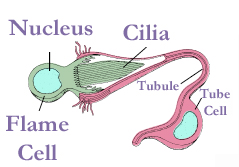Flame Cell on:
[Wikipedia]
[Google]
[Amazon]
 A flame cell is a specialized excretory cell found in the simplest freshwater
A flame cell is a specialized excretory cell found in the simplest freshwater
Animation of Excretion
Animal cells Secretory cells Urinary system
 A flame cell is a specialized excretory cell found in the simplest freshwater
A flame cell is a specialized excretory cell found in the simplest freshwater invertebrate
Invertebrates are a paraphyletic group of animals that neither possess nor develop a vertebral column (commonly known as a ''backbone'' or ''spine''), derived from the notochord. This is a grouping including all animals apart from the chordate ...
s, including flatworms, rotifers and nemertea
Nemertea is a phylum of animals also known as ribbon worms or proboscis worms, consisting of 1300 known species. Most ribbon worms are very slim, usually only a few millimeters wide, although a few have relatively short but wide bodies. Many h ...
ns; these are the simplest animals to have a dedicated excretory system
The excretory system is a passive biological system that removes excess, unnecessary materials from the body fluids of an organism, so as to help maintain internal chemical homeostasis and prevent damage to the body. The dual function of excreto ...
. Flame cells function like a kidney
The kidneys are two reddish-brown bean-shaped organs found in vertebrates. They are located on the left and right in the retroperitoneal space, and in adult humans are about in length. They receive blood from the paired renal arteries; blo ...
, removing waste materials. Bundles of flame cells are called protonephridia
The nephridium (plural ''nephridia'') is an invertebrate organ, found in pairs and performing a function similar to the vertebrate kidneys (which originated from the chordate nephridia). Nephridia remove metabolic wastes from an animal's body. Neph ...
.
The flame cell has a nucleated
The cell nucleus (pl. nuclei; from Latin or , meaning ''kernel'' or ''seed'') is a membrane-bound organelle found in eukaryotic cells. Eukaryotic cells usually have a single nucleus, but a few cell types, such as mammalian red blood cells, ...
cell body, with a "cup-shaped" projection, with flagella covering the inner surface of the cup. The beating of these flagella resemble a flame, giving the cell its name. The cup is attached to a tube cell, whose inner surface is also coated in cilia, which help to move liquid through the tube cell. The tube opens externally through a ''nephropore'', or, in the trematoda
Trematoda is a class of flatworms known as flukes. They are obligate internal parasites with a complex life cycle requiring at least two hosts. The intermediate host, in which asexual reproduction occurs, is usually a snail. The definitive h ...
, into an excretory bladder. The function of these cells is to regulate the osmotic pressure of the worm, and maintain its ionic balance. Microvilli in the tube cell may be used to reabsorb some ions.
Molecules enter the tubule in tube cells through the gap between the flame cell and tube cell for excretion.
See also
*Nephron
The nephron is the minute or microscopic structural and functional unit of the kidney. It is composed of a renal corpuscle and a renal tubule. The renal corpuscle consists of a tuft of capillaries called a glomerulus and a cup-shaped structure ...
, the similar structure in vertebrates
*Nephridia
The nephridium (plural ''nephridia'') is an invertebrate organ, found in pairs and performing a function similar to the vertebrate kidneys (which originated from the chordate nephridia). Nephridia remove metabolic wastes from an animal's body. Neph ...
, the excretory organ in annelids
The annelids (Annelida , from Latin ', "little ring"), also known as the segmented worms, are a large phylum, with over 22,000 extant species including ragworms, earthworms, and leeches. The species exist in and have adapted to various ecolog ...
*Malphigian tubule system
The Malpighian tubule system is a type of excretory and osmoregulatory system found in some insects, myriapods, arachnids and tardigrades.
The system consists of branching tubules extending from the alimentary canal that absorbs solutes, wate ...
, the excretory organ in arthropods
* Solenocyte
References
{{reflistExternal links
Animation of Excretion
Animal cells Secretory cells Urinary system